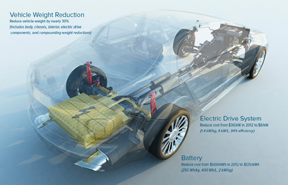New Efforts Address Electric Vehicle Affordability
 Print this Article | Send to Colleague
Print this Article | Send to Colleague

Through the first five months of 2015, according to data from Hybridcars.com, plug-in electric vehicle (PEV) sales are down in the United States by four percent from 2014. This is due, in part, to the current price of gasoline being lower than the 2014 price by $0.89 cents per gallon (per the U.S. Energy Information Administration).
The higher upfront cost of PEVs is clearly one of the major hurdles to greater electric vehicle (EV) sales, along with greater consumer awareness of their benefits in reduced fuel cost, performance, and drivability. The higher price tag precludes many prospective buyers from considering a PEV, although several models are below the current average new car transaction price of $33,363, according to Edmunds.com.
Making PEVs more affordable would bring in EV buyers from a broader audience, as data from a recent Navigant Research survey of consumers in the United States indicates that the interest in PEVs is not limited to high-income families. Of the survey respondents who reported having an income between $25,000 and $50,000 annually, fifteen percent said that they preferred their next vehicle purchase to be a PEV, which was higher than those with income of $50,000 to $150,000 annually (nine percent).
California is trying to make PEVs more appealing to lower-income families in areas where air quality is a concern. New programs for people living in the San Joaquin Valley Air Pollution Control District or South Coast Air Quality Management District provided incentives of up to $9,500 on a PEV purchase depending on the individual’s income level. While it won’t prompt a spike in nationwide sales, a successful program could encourage other regions to similarly target getting more PEVs into lower-income households.
Utilities are stepping up by creating programs to make EVs cheaper to operate and to make recharging easier. On June 8, the Edison Electric Institute signed a memorandum of understanding with the U.S. Department of Energy (DOE) that will make utilities more active participants in reducing the cost of electric transportation and to build on the DOE’s goal of making EVs as affordable as a gasoline car by 2022. Greater utility involvement is critical to reducing EVs’ operational costs as well as providing the baseline charging infrastructure for consumer confidence that EVs can be recharged wherever drivers need to go in urban areas.
Back to NAFA Connection


